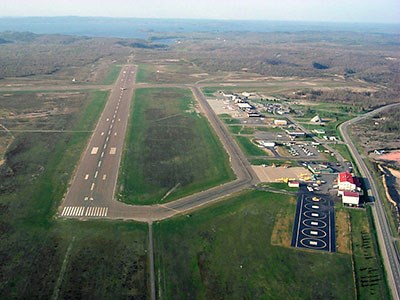The Greater Sudbury Airport will need to see significant growth in passenger traffic before WestJet Airlines considers expanding flights to Sudbury, says airport CEO Robert Johnston.
“Passenger growth drives everything in our business,” he said.
Last year, the airport accommodated 240,045 passengers, down from 246,462 in the previous year.
“Over the last year and a half I would have to admit that we've seen a bit of a struggling Sudbury economy,” Johnston said. “We're hoping that we see some improvement in that heading into 2015.”
Johnston said the airport is at the mercy of Sudbury's cyclical mining economy. When times are good, more people book flights, but in mining downturns, passenger numbers also take a dive.
“There's some small indication that the mining sector may be on the increase, so we'll just have to hang tight,” he said.
To attract WestJet or other carriers, Johnston said the airport would need to reach the 350,000 passenger mark.
While numbers could stagnate until mid-2015, Johnston said the airport has seen growth in other areas.
Last year, the airport opened its 230-acre northeast quadrant for business.
Businesses interested in setting up shop at the airport can do so without paying any development fees.
The lots – available for lease – are fully serviced by water, sewer and hydro.
Johnston said he expects most tenants looking to be part of the aviation sector to take advantage of the prime location near the runway.
But there is potential for other sectors to use the space as well.
Last year, the City of North Bay opened its airport to a wider variety of businesses with its 600-acre Airport Industrial Business Park.
So far, four companies – three of which operate in the mining supply and services sector – have taken up residence in the industrial park's southeastern quadrant.
The three mining supply and services companies – Mine Hoist International, Barrie Hard Chrome Plating and Driller's Edge – all had a presence in North Bay, but expanded their operations with the new space.
Driller's Edge, which later became a subsidiary of Edmonton-based Di-Corp, expanded to a 25,000 square foot building where it was able to employ 20 people.
For Johnston, one of the most exciting developments at the Greater Sudbury Airport is a planned 34,000-square-foot hangar that will house Discovery Aviation's flight academy and fire detection business, along with a research team from the Northern Ontario School of Medicine.
The hangar – which is expected to be complete by early 2015 – will be the airport's largest.
“Strategically, it's pretty important,” Johnston said.
He hopes it will act as a landmark that could attract more business to the airport.
Discovery Aviation and the Northern Ontario School of Medicine currently occupy a 15,000-square-foot hangar that is slated to become the Ministry of Natural Resources' new airport home.
It will be large enough to house CL-415 water bomber or a Q400 aircraft, used by Air Canada and WestJet.
The medical school collaborates with Discovery Aviation at the smaller hangar to conduct research that explores the links between environmental and human health.
Greg Ross, a researcher with the Northern Ontario School of Medicine, said moving to the larger space will allow the 25-member research team to expand further.
“We've certainly outgrown our existing arrangement,” Ross said. “This will be an amazing opportunity as we move into a bigger hangar where we can house the equipment we use together and even expand it.”
Ross and his team have used Discovery's specialized cameras and aircraft – built to detect forest fires – to identify blue-green algae blooms in Northern Ontario and list the plant life in stressed ecosystems, such as abandoned mine sites.
The research will help scientists better understand the links between Northern Ontario's environment and the health of its people.
“If you've got a healthy environment your people will be healthy, and vice versa,” Ross said.
For Johnston, the research project is one example of how the airport can expand its business footprint. “Sky's the limit for the types of diverse businesses that could set up shop at the airport,” he said.




